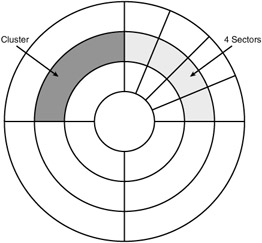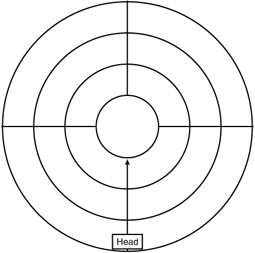What Is on a Disk
|
| < Day Day Up > |
|
To develop an understanding of the need for formatting, this review now takes a look at what is on a disk in terms of tracks, cylinders, sectors, clusters, and extents.
-
Tracks — A track is a concentric ring on the disk where data is stored. Hard drive tracks differ from compact disc (CD) tracks, which follow a spiral, as CDs are designed for continuous play and the head moves across the disk at a constant speed. Hard disks, on the other hand, are designed for random access to the data on a single track so concentric rings work better (Exhibit 5).
Exhibit 5: Tracks Are Concentric



-
Cylinders — Platters currently contain in excess of 30,000 tracks. On drives that contain multiple platters, all the tracks on all the platters that are at the same distance from the center are referred to as a cylinder. The data from all the tracks in the cylinder can be read by simply switching between the different heads, which is much faster than physically moving the head between different tracks on a single disk.
-
Sectors — The tracks are further broken down into sectors, which are the smallest units of storage on a disk. With x86-based systems, the sector size is set at 512 bytes. With earlier disk designs, each track had the same number of sectors, but that is no longer true. Because a track at the edge of a disk is about twice as long as one toward the center, it can potentially hold twice as much data. In a system referred to as zoned bit recording, a larger number of sectors are located on the outer tracks and progressively fewer toward the center which results in higher storage capacity on a disk. Because the outer tracks hold more sectors and the disk rotates at a constant speed, data can be read faster from the outer tracks than the inner ones. For this reason, it is generally better to store the most frequently accessed data on the outer tracks (Note, however, that efforts to adapt this technique to optimize file placement on disks have largely failed; particularly in an enterprise setting, efforts to place server files at specific points are unworkable due to the presence of RAID arrays, virtual volumes, and other advances that render file placement largely a lottery, a topic covered in more detail in Chapter 8).
-
Clusters — Sectors are grouped together into clusters or allocation units (Exhibit 6). As far as the operating system is concerned, all the sectors in the cluster are a single unit. How does this work out on Windows operating systems? When using Microsoft's Windows New Technology File System (NTFS; available in NT, Windows 2000, and XP), the default cluster size depends on the size of the partition. A partition (logical section of a drive) that is 512 MB or smaller would have clusters each consisting of a single 512-byte sector, while a partition over 2 GB would have clusters consisting of eight 4096-byte sectors. When creating the file system for a partition, the administrator can create cluster sizes up to 64 kilobytes (KB). Setting the clusters too small for the type of files on the disk results in the files being split among too many clusters. Setting the size too large reduces this problem but reduces the actual storage capacity of the disk. If a file is smaller than the cluster, the rest of the storage capacity of that cluster is unavailable. If the file is larger than a single cluster, the rest of the data is stored in one or more additional clusters.
Exhibit 6: Sectors and Clusters



-
Extents — A set of contiguous clusters storing a single file, or part of a file, is called an extent. It is best to keep the number of extents for any file to a minimum, as each extent requires a separate input/output operation (I/O). Reducing the number of extents in a file using a process known as defragmentation greatly improves performance (Exhibit 7).
Exhibit 7: Extent



Disk Performance Definitions and Metrics
Some further definitions are provided regarding the performance of disks and their basic duties:
-
Seek — To locate data on a specific part of a disk or to be in the correct position to retrieve data, program instructions etc., the head must move from one track to another. This action is referred to as a seek.
-
Seek time — The time it takes for the head to move from one track to another is the seek time. It is the most important factor in determining the speed of a disk and can be broken down into three elements: (1) the time it takes to move the head from a stationary position until it is moving at full speed; (2) the time expended in moving the head from one track to another; and (3) the time required to stop the head. Note that if a file is fragmented, many additional seeks are necessary to open the file. Also note that, in its truest sense, seek time really only means the time it takes for the head to move across the disk perpendicular to the tracks (Exhibit 8).
Exhibit 8: Seek Time



-
Rotational latency — It is much quicker to access data that is immediately under the head, in which case all the head has to do is move toward or away from the center of the disk to access it. If, however, the head has just passed the point on the disk where the data resides, it has to rotate almost a complete circle in order to access the data. This situation is known as rotational latency. For a disk spinning at 7500 rpm, it takes a little over 8 ms for the head to complete a 360-degree rotation on the disk; therefore, rotational latency can vary from 0 to 8 ms on such a disk and averages around 4 ms.
-
Access time — A combination of seek time plus rotational latency. This gives the time it takes to access a cluster. Sometimes, people use the term seek time interchangeably with access time.
To apply these concepts, consider Maxtor's DiamondMax 80, which is touted as a high-performance drive and has a rotation speed of 5400 rpm. Seek time from track to track is 1 ms. When rotational latency is factored in, it takes the head an average of about 10 ms per seek, but it can take as much as 20 ms. Seagate's Cheetah drive spins at 15,000 rpm and has an average seek time (track to track) of 0.2 to 0.4 ms, with an average rotational latency of 2.0 ms. On average, a seek takes 3.6 to 4.0 ms. Interestingly, when you compare these numbers to the hard drives of ten years ago, the pace of advance is much slower than that for other components such as CPUs and RAM.
Disk Formatting
As discussed above, the substrate of the hard disk is coated so as to retain data; however, for data to be stored on a disk it must first be formatted. This is a three-step process. The first action, low-level formatting (LLF), is usually done by the manufacturer. LLF designates the tracks and sectors on a disk by recording markers on the surface that show where they start. After LLF of the disk, the second step is partitioning (or initializing). Partitioning reserves a part of a disk for a certain function, and the operating system considers each partition as a separate drive. Users who want the entire disk to be a single partition must specify just that. When using dynamic disks in UNIX or Windows 2000, the term volume is used rather than partition. The third formatting step, high-level formatting, consists of putting the file structure on the disk (file systems are covered in more depth in Chapter 2).
|
| < Day Day Up > |
|
EAN: N/A
Pages: 197